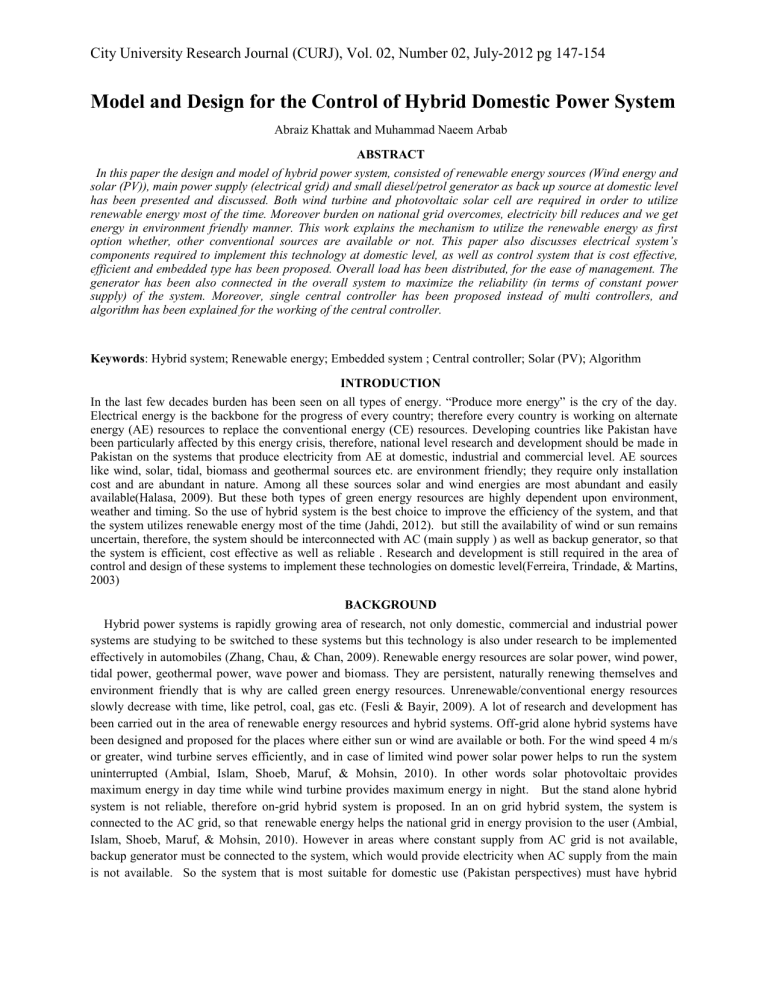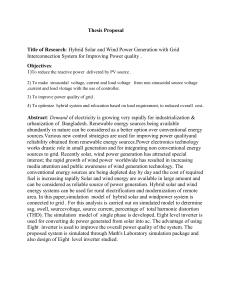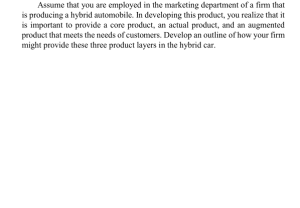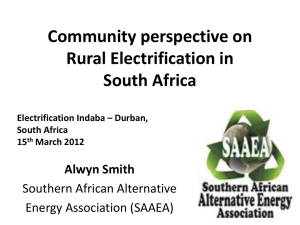
City University Research Journal (CURJ), Vol. 02, Number 02, July-2012 pg 147-154 Model and Design for the Control of Hybrid Domestic Power System Abraiz Khattak and Muhammad Naeem Arbab ABSTRACT In this paper the design and model of hybrid power system, consisted of renewable energy sources (Wind energy and solar (PV)), main power supply (electrical grid) and small diesel/petrol generator as back up source at domestic level has been presented and discussed. Both wind turbine and photovoltaic solar cell are required in order to utilize renewable energy most of the time. Moreover burden on national grid overcomes, electricity bill reduces and we get energy in environment friendly manner. This work explains the mechanism to utilize the renewable energy as first option whether, other conventional sources are available or not. This paper also discusses electrical system’s components required to implement this technology at domestic level, as well as control system that is cost effective, efficient and embedded type has been proposed. Overall load has been distributed, for the ease of management. The generator has been also connected in the overall system to maximize the reliability (in terms of constant power supply) of the system. Moreover, single central controller has been proposed instead of multi controllers, and algorithm has been explained for the working of the central controller. Keywords: Hybrid system; Renewable energy; Embedded system ; Central controller; Solar (PV); Algorithm INTRODUCTION In the last few decades burden has been seen on all types of energy. “Produce more energy” is the cry of the day. Electrical energy is the backbone for the progress of every country; therefore every country is working on alternate energy (AE) resources to replace the conventional energy (CE) resources. Developing countries like Pakistan have been particularly affected by this energy crisis, therefore, national level research and development should be made in Pakistan on the systems that produce electricity from AE at domestic, industrial and commercial level. AE sources like wind, solar, tidal, biomass and geothermal sources etc. are environment friendly; they require only installation cost and are abundant in nature. Among all these sources solar and wind energies are most abundant and easily available(Halasa, 2009). But these both types of green energy resources are highly dependent upon environment, weather and timing. So the use of hybrid system is the best choice to improve the efficiency of the system, and that the system utilizes renewable energy most of the time (Jahdi, 2012). but still the availability of wind or sun remains uncertain, therefore, the system should be interconnected with AC (main supply ) as well as backup generator, so that the system is efficient, cost effective as well as reliable . Research and development is still required in the area of control and design of these systems to implement these technologies on domestic level(Ferreira, Trindade, & Martins, 2003) BACKGROUND Hybrid power systems is rapidly growing area of research, not only domestic, commercial and industrial power systems are studying to be switched to these systems but this technology is also under research to be implemented effectively in automobiles (Zhang, Chau, & Chan, 2009). Renewable energy resources are solar power, wind power, tidal power, geothermal power, wave power and biomass. They are persistent, naturally renewing themselves and environment friendly that is why are called green energy resources. Unrenewable/conventional energy resources slowly decrease with time, like petrol, coal, gas etc. (Fesli & Bayir, 2009). A lot of research and development has been carried out in the area of renewable energy resources and hybrid systems. Off-grid alone hybrid systems have been designed and proposed for the places where either sun or wind are available or both. For the wind speed 4 m/s or greater, wind turbine serves efficiently, and in case of limited wind power solar power helps to run the system uninterrupted (Ambial, Islam, Shoeb, Maruf, & Mohsin, 2010). In other words solar photovoltaic provides maximum energy in day time while wind turbine provides maximum energy in night. But the stand alone hybrid system is not reliable, therefore on-grid hybrid system is proposed. In an on grid hybrid system, the system is connected to the AC grid, so that renewable energy helps the national grid in energy provision to the user (Ambial, Islam, Shoeb, Maruf, & Mohsin, 2010). However in areas where constant supply from AC grid is not available, backup generator must be connected to the system, which would provide electricity when AC supply from the main is not available. So the system that is most suitable for domestic use (Pakistan perspectives) must have hybrid City University Research Journal (CURJ), Vol. 02, Number 02, July-2012 pg 147-154 power system consisting of wind power system, solar power system, AC main supply from grid and also diesel/petrol generator. Research and development has been made on the control and management of on grid/off grid hybrid power system(Prasad & Srinivasan, 2010). But limited work has been done to make this technology handy to the domestic user. Still further study and research are needed to design, test and analyze the hybrid systems for domestic use. HYBRID POWER SYSTEM A. Wind energy Wind turbine is used to convert natural wind energy into mechanical energy, and then to convert that mechanical energy into electrical energy a generator must be connected with the turbine. There are two major types of Electrical power outputs we get from wind energy i.e. DC and AC, as we have to store the wind power as DC so DC-DC converter is used for DC generator while AC-DC-DC converter is used for alternator. To avoid extra rectifier’s circuit, DC generator should be used with the wind turbine. For the storage of converter’s output The output of the converter an accumulator is used, which is usually a DC battery normally 12V or 24V. This stored DC power is then utilized as AC power after passing it through inverter. (Suzuki, Ph, Okitsu, Ph, & Kawahito, 1982),(Singh, Member, Santoso, & Member, 2011). B. Solar energy Solar energy is called the mother of all energies. Two ways normally used to convert solar energy into electrical energy either heat energy of the sun or its light energy is used for this conversion. In latter semiconductor sheet called photovoltaic cell (solar panel) is used to convert light energy into electrical energy. By solar radiation electrons of the semiconductor are excited these electrons are flowed by connecting electrodes at both sides of the semiconductor sheet. The output power of the photovoltaic cell is DC and is stored in battery, after passing it through DC-DC converter(Walker & Sernia, 2004). To utilize this power for domestic use it is converted into 220V AC voltage. The electrical energy produced from solar panel and wind turbine can be stored in separate batteries but using single combined battery or battery bank for both energies is preferable, this minimize the expenses and simplifies the controlling, for the central controller (Crabtree & Lewis, 2007). C. AC ( Main) Supply and diesel/petrol generator The system is connected to AC (main supply) for the provision of uninterrupted supply. This type of hybrid system is termed as an on-grid hybrid system. In Pakistan, it is important to consider the irregular AC supply from grid; therefore, in order to design the reliable system, it is proposed to be connected with backup generator. In case of low or no supply from wind and solar, when AC (Main) supply is not available (at the time of load shedding) then the generator would automatically supply the required AC power instead of AC (main) supply. Figure 1 shows domestic hybrid system that uses solar photovoltaic cell, wind turbine and is connected with AC (main) supply and also with a backup generator. To design this system for domestic use, low cost and small size controller is needed to control and manage all the system. The main priority of the controller is to utilize the renewable energy resources even if the AC (main) supply or backup generator is available. If the hybrid system’s energy is not sufficient to supply the whole load then a portion of the load utilizes the solar and wind energy, and the rest of the system is supplied from national grid or backup generator, meanwhile extra energy from the wind/solar is stored in the accumulator (DC battery). Moreover, there should be a constant interface (display) for the user with the system to observe the status of the system i.e. to know that which portion of load has been connected with which source of energy. Main role in the design of this system is that of the controller that controls and manages the whole process. City University Research Journal (CURJ), Vol. 02, Number 02, July-2012 pg 147-154 . Figure 1: Hybrid power system with backup generator BLOCK DIAGRAM AND MODEL DESCRIPTION OF THE SYSTEM A. Load distribution and sources connection Following Figure 2 shows the block diagram model of the entire hybrid system for domestic use, which consists of photovoltaic cell (solar panel), wind turbine, DC generator, DC-DC converters, DC battery, Inverter, controls (switches), AC main supply, diesel/petrol generator and load. In this figure it is clear that overall load has been distributed into three loads i.e. Load1, Load2 and Load3. City University Research Journal (CURJ), Vol. 02, Number 02, July-2012 pg 147-154 Figure 2: Block diagram model of domestic hybrid power system As it can be seen in block diagram that all of the three loads have a connection each via control switch. One connection of the control switch is from renewable sources of energy i.e. wind and solar through battery and inverter, and other connection is from AC (main) supply. As shown in the model two control switches have been used between load and AC supply; the first control(s) switch is used to connect the generator when there is no supply from AC (main) grid and other small controls connected with three parts of load that connects or disconnects each load from AC supply or generator. It is further added that all the three portions of loads can be connected to the same line LR ( supply line coming from battery through inverter) or LC ( supply line coming from AC ( main) supply or backup generator) or may be with different lines at the same time but one load can be connected with either lines LR or LC . B. Central Controller and Auxillary components Instead of using different controllers (multi controllers) to perform the necessary task, it is better to use single central controller for controlling the overall system. Central controller can be called the mastermind of the proposed hybrid power system, which has different inputs and outputs. Figure 3 shows the labeled block diagram of central controller. It has two inputs, first input is from DC battery and second input is from AC (main) supply point but through auxiliary components like step down transformer and analogue to digital converter etc. Central controller has four outputs (control lines), three for connecting each load to the supply line ( LC ) or to the line ( LR ) . All the outputs of central controller are connected with controls (switches) further to perform the required action decided by the central controller. In circuit, Relays are preferable to be used in place of control switches. Microcontroller unit is the best choice to be used as central controller. In order to make the central controller work efficiently, a proper simple algorithm is needed that takes into account all the major parameters of the design. In next section flowchart design for the working of central controller is presented. City University Research Journal (CURJ), Vol. 02, Number 02, July-2012 pg 147-154 Input from AC (main supply) indirect Input from DC battery Central Controller and Auxiliary components Outputs connected for selection of LR and LC Output for selection of AC (main) Figure 3: Central controller block with inputs and outputs FLOW CHART AND ALGORITHM OF THE SYSTEM Figure 4 systematically explains the algorithm of the proposed hybrid power system with the help of the flowchart. The system aims to be designed such that maximum utilization of renewable energies (wind and solar) is achieved. In the design of control system highest priority is given to the battery. For the ease of controlling and management the battery voltage (VB) has been defined in steps for central controller i.e. V B ≥ V1, V1 > VB ≥ V2, V2> VB ≥ V3, and VB < V3. While V3> V2 > V1. V1 is battery voltage when the battery is sufficiently charged. V2 is battery voltage when it is moderately charged and V3 is the voltage when battery is lightly charged and can be used for light loads. As mentioned earlier that overall load has been distributed further in three different loads. In flow chart load1, load2 and load3 have been denoted by L1, L2 and L3 respectively. At the start AC (main) and generator do not supply power to any portion of the load, the controller checks the battery voltage if it is equal to or greater than V1 (has been taken the dc voltage value that can supply all the three loads uninterruptedly), all the loads L1, L2 and L3 are connected with the supply line LR. If the battery voltage is greater than or equal to V2 and less than V3 then L1and L2 are connected to line LR, and L3 is connected to the supply line LC. If the battery voltage is greater than or equal to V1 and less than V2 then L1 is connected with the supply line LR, and L2 and L3 are connected with supply line Lc. If the battery voltage is less than V3 then all loads i.e. load1, load2, and load3 are switched to the supply line Lc. During all this process the central controller continuously checks the status of AC main supply system if it is not available then the control(s) switch is turned to the backup generator, and the supply is available on line LC. City University Research Journal (CURJ), Vol. 02, Number 02, July-2012 pg 147-154 Start Yes VB ≥ V1 Battery gives supply to L1, L2, and L3 through inverter. No AC (Main) VBYes ≥ V2 Yes No Battery gives supply to L1 and L2 through inverter. AC (Main) No VB ≥ V3 Yes Yes AC (main) gives supply to L3 Generator gives supply to L3 Yes AC (main) gives supply L2 and L3 No Battery gives supply to L1 through inverter. Generator gives supply L2 and L3 No AC (Main) Yes AC (main) gives supply to L1, L2, and L3 No Generator gives supply to L1, L2, and L3 Return Display the status of the system to the user Figure 4: Flowchart representing the algorithm for the central controller City University Research Journal (CURJ), Vol. 02, Number 02, July-2012 pg 147-154 CONCLUSION In this work the hybrid domestic power system has been designed from Pakistan perspectives, the design has been made, which combines two renewable energy sources i.e. wind energy and solar energy proposed to be implemented as on-grid hybrid power system, also generator has been connected in the design as back up source, so that the system is reliable. Single central controller is proposed instead of several controllers, this will make system more cost effective and efficient. Moreover load distribution has been made for the ease of sources management. This project has a wide scope for windy or sunny areas or both. REFEFRENCES Ambial, M. N., Islam, K., Shoeb, A., Maruf, N. I., & Mohsin, A. S. M. (2010). An Analysis & Design on Micro Generation of A Domestic Solar-Wind Hybrid Energy System for Rural & Remote Areas - Perspective Bangladesh Solar Power Wind Power. Engineering, 2(Icmee), 107-110. Crabtree, G. W., & Lewis, N. S. (2007). Solar energy conversion, (March), 37-42. Ferreira, P., Trindade, M., & Martins, J. (2003). Interfaces for renewable energy sources with electric power systems. Renewable Energy, (May 2003), 1-6. Retrieved from http://repositorium.sdum.uminho.pt/handle/1822/1528 Fesli, U., & Bayir, R. (2009). Design and implementation of a domestic solar-wind hybrid energy system. Electrical and Electronics, 29-33. Retrieved from http://ieeexplore.ieee.org/xpls/abs_all.jsp?arnumber=5355323 Halasa, G. (2009). Wind-solar hybrid electrical power production to support national grid: Case study-Jordan. Power Electronics and Motion, 3, 903-909. Retrieved from http://ieeexplore.ieee.org/xpls/abs_all.jsp?arnumber=5157513 Jahdi, S. (2012). Renewable Hybrids Grid-Connection Using Converter Interferences Loi Lei Lai 3 . Grid Connection Power Electronic. International Journal of Sustainable Energy, 1(June), 51-57. Prasad, G., & Srinivasan, S. (2010). Hybrid Solar and Wind Off-Grid System-Design and Control. International, 2(4), 548-552. Retrieved from http://journals.indexcopernicus.com/abstracted.php?icid=939288 Singh, M., Member, S., Santoso, S., & Member, S. (2011). Dynamic Model for Full-Converter Wind Turbines employing Permanent Magnet Alternators, 1-7. Suzuki, T., Ph, D., Okitsu, H., Ph, D., & Kawahito, T. (1982). Characteristics of a small wind-power system with DC generator, 129(4), 217-220. Walker, G. R., & Sernia, P. C. (2004). Cascaded DC – DC Converter Connection of Photovoltaic Modules, 19(4), 1130-1139. Zhang, X., Chau, K., & Chan, C. (2009). Design and implementation of a thermoelectric-photovoltaic hybrid energy source for hybrid electric vehicles. World Electric Vehicle Journal, 3, 1–11. European Association for Battery, Hybrid and Fuel Cell Electric Vehicles (AVERE). The Journal’s web site is located at http://www. evs24. org/wevajournal/index. html. Retrieved from http://hub.hku.hk/handle/10722/129199 City University Research Journal (CURJ), Vol. 02, Number 02, July-2012 pg 147-154 Abraiz Khattak: has worked as lecturer at Peshawar College of Engineering (U.E.T Peshawar), Pakistan and Information Technology (CUSIT) Peshawar, Pakistan. He has two years teaching experience in the field of electrical engineering, doing masters (MS) in Electrical (power) engineering from University of Engineering & Technology Peshawar. Renewable energy, power system control, and embedded systems are his major areas of research. Presently working as lecturer in the department of electrical engineering of City University of Science. E-mail: engrabraiz@yahoo.com Muhammad Naeem Arbab: Presently working as Professor in the department of Electrical Engineering of University of Engineering and Technology (U.E.T) Peshawar, Pakistan. He received his M.Sc. and Ph.D. degrees from the University of Manchester, UK in 1985 and 1987 respectively. His field of specialization is High Voltage Engineering in the area of Electrical Power. He has 23 years of teaching and research experience and has supervised numerous students in their M.Sc. research. He has written 23 research papers and has recently completed a book on High Voltage Engineering. E-mail: mnarbab@gmail.com


